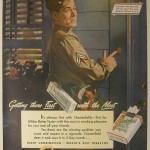Although tobacco has been commercially grown in the United States since 1612, American tobacco advertisement originated in 1789 in the form of a Lorillard brothers sponsored newspaper ad. From black and white newspaper ads, tobacco and cigarette advertisements expanded towards attractive and colorful thanks to the development of color lithography in the late 1870s. These iconic and collectible trading cards were included in cigarette packs that were offered by a variety of cigarette manufacturers at the time. The introduction of color advertisements and aesthetically beautiful marketing tools was followed by the “invention of the first practical cigarette making machine”[1] in 1880, which enabled producers to manufacture and distribute their product at much more efficient rate.
In the first half of the 20th century, cigarette popularity continued to grow amongst American consumers, thanks in large part to more sophisticated domestic advertising campaigns, and the prevalence of cigarettes amongst soldiers in WWI & WWII. Soldiers fighting in World War I represented “an early target audience”[2] for cigarettes, as this population subgroup was regarded as a key consumption group throughout the rest of the century. “During World War II, the Korean War, and the Vietnam War, free samples were a part of combat rations and were easily obtained at low cost form the commissaries on military bases.”[3]
Aside from the military, the male consumers were leading targets of tobacco advertisement in the first decades of the 20th century, “representing 95% of the market.”[4]
[1] “A Brief History of Tobacco.” CNN. Cable News Network, n.d. Web.
[2] [3] [4] National Cancer Institute. The Role of the Media in Promoting and Reducing Tobacco Use. N.p.: CreateSpace Independent Platform, 2012. Print.

